Greenhouse Gas Reduction by Mining Companies and Productivity Analysis
VerifiedAdded on 2023/06/04
|19
|4818
|110
Report
AI Summary
This report investigates the correlation between greenhouse gas (GHG) emissions reduction and financial performance within the mining sector, focusing on BHP and Rio Tinto. The research explores the significance of environmental concerns, the role of mining companies in GHG emissions, and the need for sustainable practices. The report includes an introduction outlining the context of global warming, climate change, and the importance of corporate social responsibility (CSR). It provides background information on the mining industry in Australia, highlighting the country's significant mineral resources and reliance on coal as a primary energy source. The aims and objectives are clearly defined, followed by research questions addressing GHG emission rates, emission reduction initiatives, the impact on financial performance, and recommendations. A detailed literature review examines the UN's sustainable development goals, the effects of climate change, and existing research on the relationship between GHG emissions and financial performance. The research methodology, including the deductive approach, data collection methods, and analysis techniques, is described. The report analyzes the empirical relationships between GHG emissions and business performance measures and discusses the findings, conclusions, recommendations, and limitations of the research.
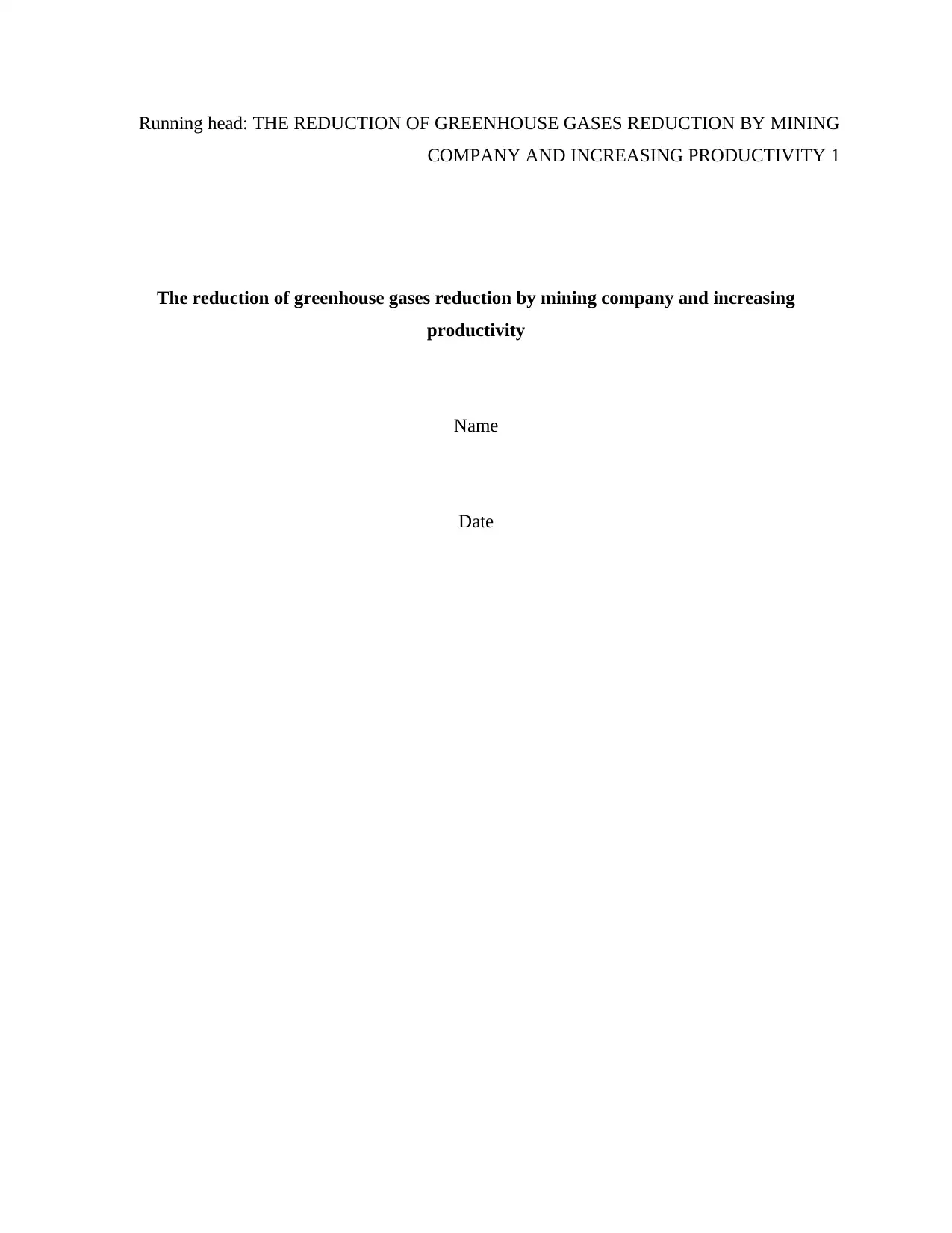
Running head: THE REDUCTION OF GREENHOUSE GASES REDUCTION BY MINING
COMPANY AND INCREASING PRODUCTIVITY 1
The reduction of greenhouse gases reduction by mining company and increasing
productivity
Name
Date
COMPANY AND INCREASING PRODUCTIVITY 1
The reduction of greenhouse gases reduction by mining company and increasing
productivity
Name
Date
Paraphrase This Document
Need a fresh take? Get an instant paraphrase of this document with our AI Paraphraser
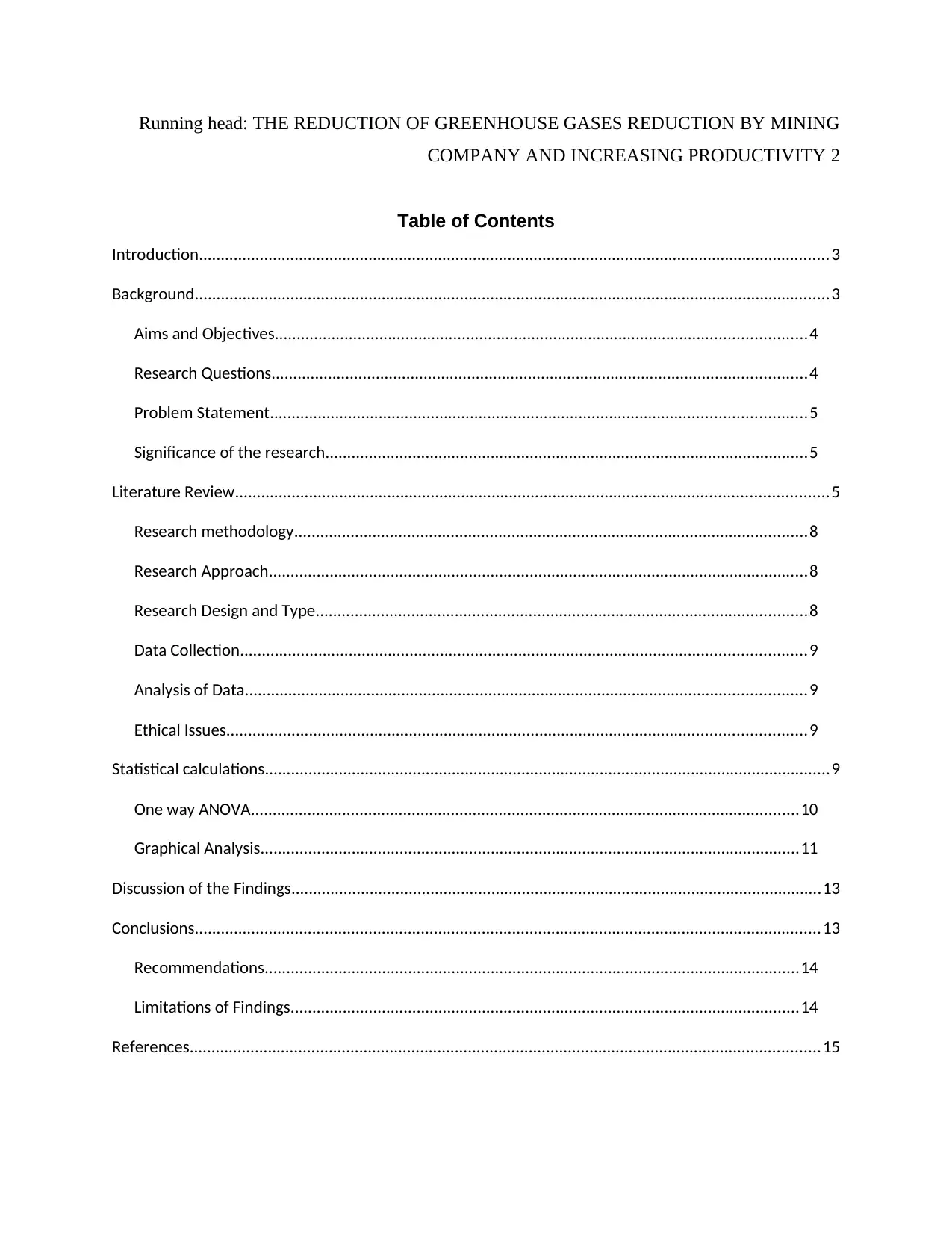
Running head: THE REDUCTION OF GREENHOUSE GASES REDUCTION BY MINING
COMPANY AND INCREASING PRODUCTIVITY 2
Table of Contents
Introduction.................................................................................................................................................3
Background..................................................................................................................................................3
Aims and Objectives..........................................................................................................................4
Research Questions...........................................................................................................................4
Problem Statement...........................................................................................................................5
Significance of the research...............................................................................................................5
Literature Review........................................................................................................................................5
Research methodology......................................................................................................................8
Research Approach............................................................................................................................8
Research Design and Type.................................................................................................................8
Data Collection..................................................................................................................................9
Analysis of Data.................................................................................................................................9
Ethical Issues.....................................................................................................................................9
Statistical calculations..................................................................................................................................9
One way ANOVA..............................................................................................................................10
Graphical Analysis............................................................................................................................11
Discussion of the Findings..........................................................................................................................13
Conclusions................................................................................................................................................13
Recommendations...........................................................................................................................14
Limitations of Findings.....................................................................................................................14
References.................................................................................................................................................15
COMPANY AND INCREASING PRODUCTIVITY 2
Table of Contents
Introduction.................................................................................................................................................3
Background..................................................................................................................................................3
Aims and Objectives..........................................................................................................................4
Research Questions...........................................................................................................................4
Problem Statement...........................................................................................................................5
Significance of the research...............................................................................................................5
Literature Review........................................................................................................................................5
Research methodology......................................................................................................................8
Research Approach............................................................................................................................8
Research Design and Type.................................................................................................................8
Data Collection..................................................................................................................................9
Analysis of Data.................................................................................................................................9
Ethical Issues.....................................................................................................................................9
Statistical calculations..................................................................................................................................9
One way ANOVA..............................................................................................................................10
Graphical Analysis............................................................................................................................11
Discussion of the Findings..........................................................................................................................13
Conclusions................................................................................................................................................13
Recommendations...........................................................................................................................14
Limitations of Findings.....................................................................................................................14
References.................................................................................................................................................15
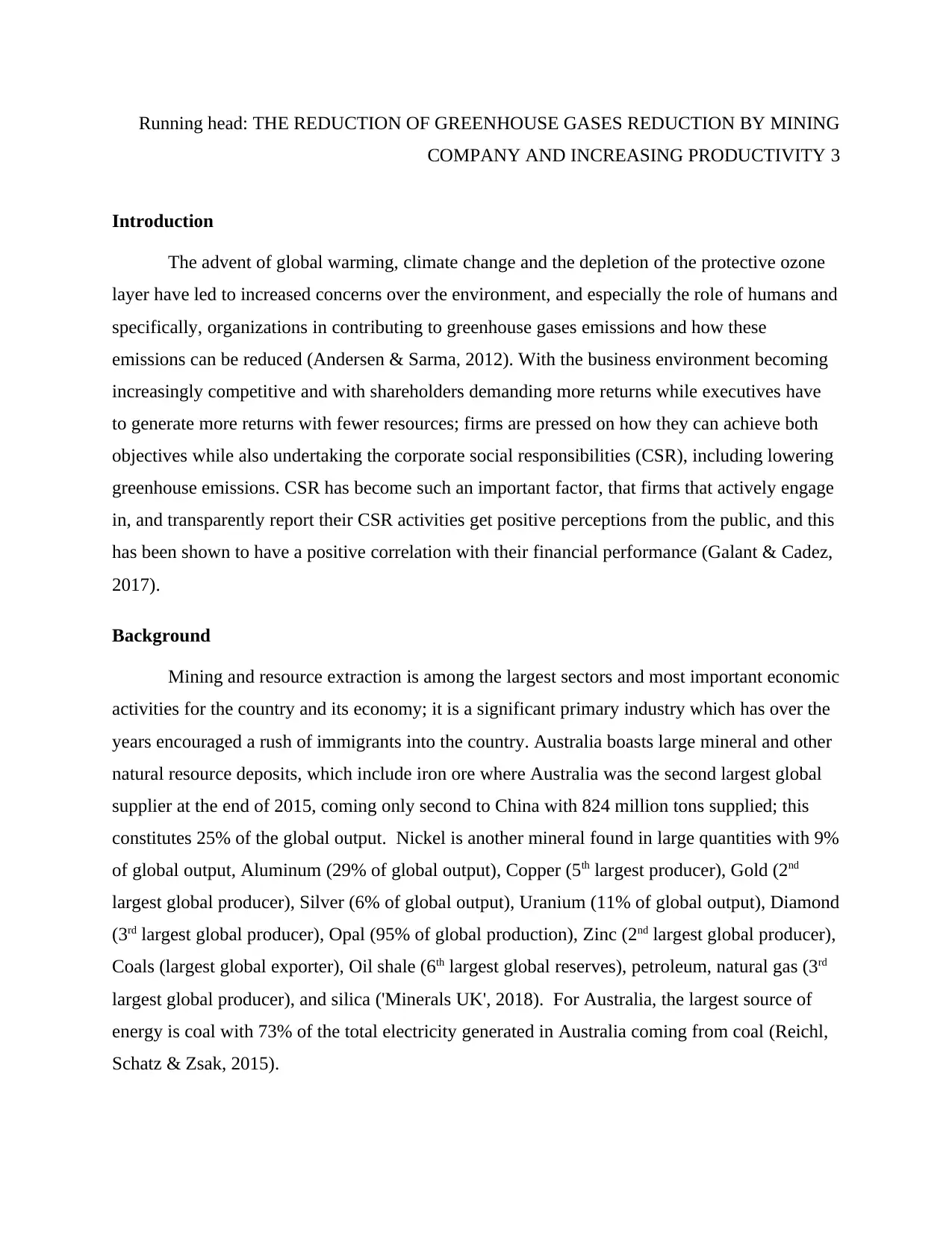
Running head: THE REDUCTION OF GREENHOUSE GASES REDUCTION BY MINING
COMPANY AND INCREASING PRODUCTIVITY 3
Introduction
The advent of global warming, climate change and the depletion of the protective ozone
layer have led to increased concerns over the environment, and especially the role of humans and
specifically, organizations in contributing to greenhouse gases emissions and how these
emissions can be reduced (Andersen & Sarma, 2012). With the business environment becoming
increasingly competitive and with shareholders demanding more returns while executives have
to generate more returns with fewer resources; firms are pressed on how they can achieve both
objectives while also undertaking the corporate social responsibilities (CSR), including lowering
greenhouse emissions. CSR has become such an important factor, that firms that actively engage
in, and transparently report their CSR activities get positive perceptions from the public, and this
has been shown to have a positive correlation with their financial performance (Galant & Cadez,
2017).
Background
Mining and resource extraction is among the largest sectors and most important economic
activities for the country and its economy; it is a significant primary industry which has over the
years encouraged a rush of immigrants into the country. Australia boasts large mineral and other
natural resource deposits, which include iron ore where Australia was the second largest global
supplier at the end of 2015, coming only second to China with 824 million tons supplied; this
constitutes 25% of the global output. Nickel is another mineral found in large quantities with 9%
of global output, Aluminum (29% of global output), Copper (5th largest producer), Gold (2nd
largest global producer), Silver (6% of global output), Uranium (11% of global output), Diamond
(3rd largest global producer), Opal (95% of global production), Zinc (2nd largest global producer),
Coals (largest global exporter), Oil shale (6th largest global reserves), petroleum, natural gas (3rd
largest global producer), and silica ('Minerals UK', 2018). For Australia, the largest source of
energy is coal with 73% of the total electricity generated in Australia coming from coal (Reichl,
Schatz & Zsak, 2015).
COMPANY AND INCREASING PRODUCTIVITY 3
Introduction
The advent of global warming, climate change and the depletion of the protective ozone
layer have led to increased concerns over the environment, and especially the role of humans and
specifically, organizations in contributing to greenhouse gases emissions and how these
emissions can be reduced (Andersen & Sarma, 2012). With the business environment becoming
increasingly competitive and with shareholders demanding more returns while executives have
to generate more returns with fewer resources; firms are pressed on how they can achieve both
objectives while also undertaking the corporate social responsibilities (CSR), including lowering
greenhouse emissions. CSR has become such an important factor, that firms that actively engage
in, and transparently report their CSR activities get positive perceptions from the public, and this
has been shown to have a positive correlation with their financial performance (Galant & Cadez,
2017).
Background
Mining and resource extraction is among the largest sectors and most important economic
activities for the country and its economy; it is a significant primary industry which has over the
years encouraged a rush of immigrants into the country. Australia boasts large mineral and other
natural resource deposits, which include iron ore where Australia was the second largest global
supplier at the end of 2015, coming only second to China with 824 million tons supplied; this
constitutes 25% of the global output. Nickel is another mineral found in large quantities with 9%
of global output, Aluminum (29% of global output), Copper (5th largest producer), Gold (2nd
largest global producer), Silver (6% of global output), Uranium (11% of global output), Diamond
(3rd largest global producer), Opal (95% of global production), Zinc (2nd largest global producer),
Coals (largest global exporter), Oil shale (6th largest global reserves), petroleum, natural gas (3rd
largest global producer), and silica ('Minerals UK', 2018). For Australia, the largest source of
energy is coal with 73% of the total electricity generated in Australia coming from coal (Reichl,
Schatz & Zsak, 2015).
⊘ This is a preview!⊘
Do you want full access?
Subscribe today to unlock all pages.

Trusted by 1+ million students worldwide
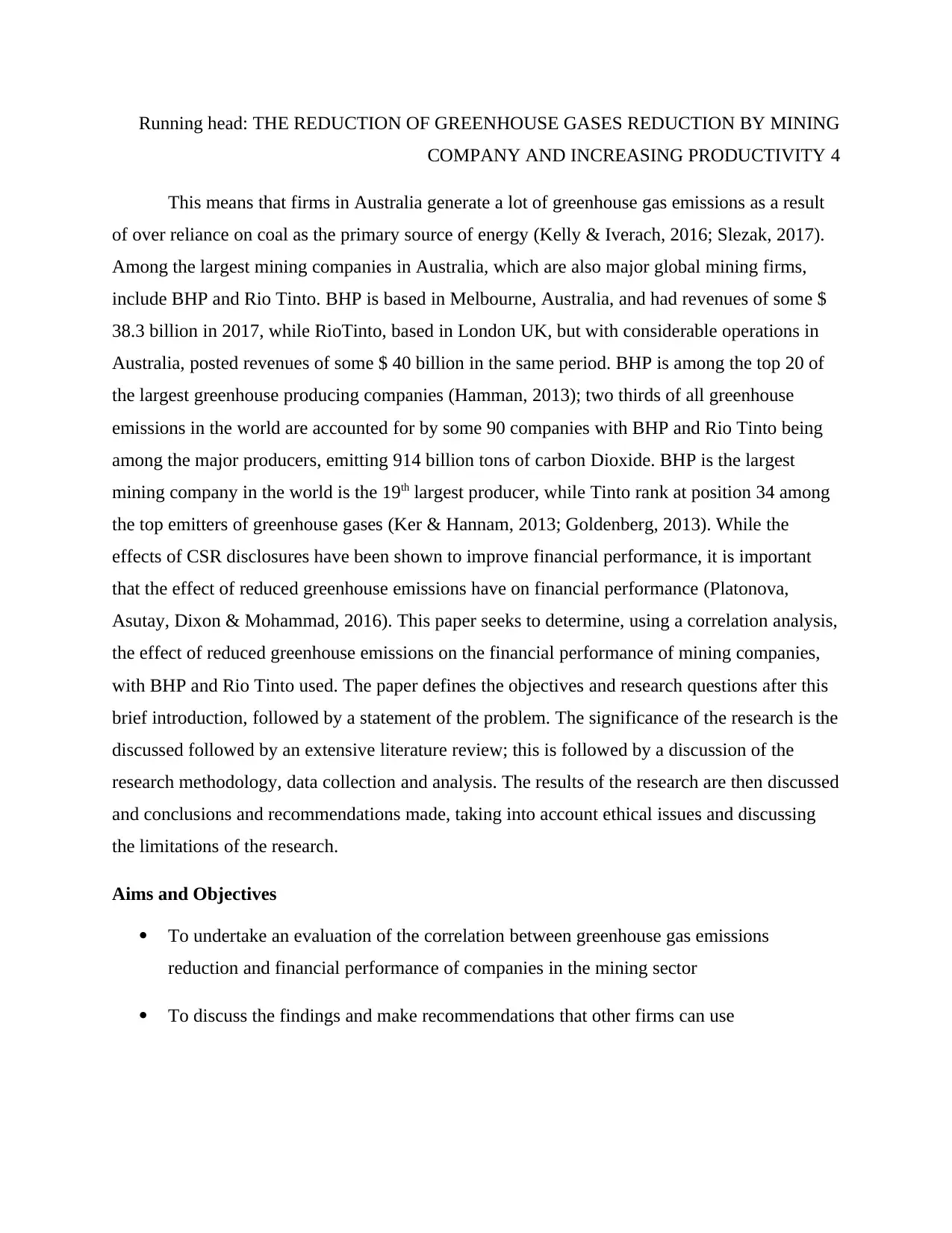
Running head: THE REDUCTION OF GREENHOUSE GASES REDUCTION BY MINING
COMPANY AND INCREASING PRODUCTIVITY 4
This means that firms in Australia generate a lot of greenhouse gas emissions as a result
of over reliance on coal as the primary source of energy (Kelly & Iverach, 2016; Slezak, 2017).
Among the largest mining companies in Australia, which are also major global mining firms,
include BHP and Rio Tinto. BHP is based in Melbourne, Australia, and had revenues of some $
38.3 billion in 2017, while RioTinto, based in London UK, but with considerable operations in
Australia, posted revenues of some $ 40 billion in the same period. BHP is among the top 20 of
the largest greenhouse producing companies (Hamman, 2013); two thirds of all greenhouse
emissions in the world are accounted for by some 90 companies with BHP and Rio Tinto being
among the major producers, emitting 914 billion tons of carbon Dioxide. BHP is the largest
mining company in the world is the 19th largest producer, while Tinto rank at position 34 among
the top emitters of greenhouse gases (Ker & Hannam, 2013; Goldenberg, 2013). While the
effects of CSR disclosures have been shown to improve financial performance, it is important
that the effect of reduced greenhouse emissions have on financial performance (Platonova,
Asutay, Dixon & Mohammad, 2016). This paper seeks to determine, using a correlation analysis,
the effect of reduced greenhouse emissions on the financial performance of mining companies,
with BHP and Rio Tinto used. The paper defines the objectives and research questions after this
brief introduction, followed by a statement of the problem. The significance of the research is the
discussed followed by an extensive literature review; this is followed by a discussion of the
research methodology, data collection and analysis. The results of the research are then discussed
and conclusions and recommendations made, taking into account ethical issues and discussing
the limitations of the research.
Aims and Objectives
To undertake an evaluation of the correlation between greenhouse gas emissions
reduction and financial performance of companies in the mining sector
To discuss the findings and make recommendations that other firms can use
COMPANY AND INCREASING PRODUCTIVITY 4
This means that firms in Australia generate a lot of greenhouse gas emissions as a result
of over reliance on coal as the primary source of energy (Kelly & Iverach, 2016; Slezak, 2017).
Among the largest mining companies in Australia, which are also major global mining firms,
include BHP and Rio Tinto. BHP is based in Melbourne, Australia, and had revenues of some $
38.3 billion in 2017, while RioTinto, based in London UK, but with considerable operations in
Australia, posted revenues of some $ 40 billion in the same period. BHP is among the top 20 of
the largest greenhouse producing companies (Hamman, 2013); two thirds of all greenhouse
emissions in the world are accounted for by some 90 companies with BHP and Rio Tinto being
among the major producers, emitting 914 billion tons of carbon Dioxide. BHP is the largest
mining company in the world is the 19th largest producer, while Tinto rank at position 34 among
the top emitters of greenhouse gases (Ker & Hannam, 2013; Goldenberg, 2013). While the
effects of CSR disclosures have been shown to improve financial performance, it is important
that the effect of reduced greenhouse emissions have on financial performance (Platonova,
Asutay, Dixon & Mohammad, 2016). This paper seeks to determine, using a correlation analysis,
the effect of reduced greenhouse emissions on the financial performance of mining companies,
with BHP and Rio Tinto used. The paper defines the objectives and research questions after this
brief introduction, followed by a statement of the problem. The significance of the research is the
discussed followed by an extensive literature review; this is followed by a discussion of the
research methodology, data collection and analysis. The results of the research are then discussed
and conclusions and recommendations made, taking into account ethical issues and discussing
the limitations of the research.
Aims and Objectives
To undertake an evaluation of the correlation between greenhouse gas emissions
reduction and financial performance of companies in the mining sector
To discuss the findings and make recommendations that other firms can use
Paraphrase This Document
Need a fresh take? Get an instant paraphrase of this document with our AI Paraphraser

Running head: THE REDUCTION OF GREENHOUSE GASES REDUCTION BY MINING
COMPANY AND INCREASING PRODUCTIVITY 5
Research Questions
1. What are the green house emission rates of BHP and Rio Tinto and how do they
compare?
2. Have the firms been involved in active initiatives to reduce greenhouse gas emissions?
3. How has reducing greenhouse emissions affected financial performance, how are the two
correlated?
4. What recommendations can be made based on these findings?
Problem Statement
Greenhouse gas emissions has become an urgent pressing matter, that can lead to adverse
and possibly irreversible effects on the environment, life, and the world as we know it in general
(Stover, 2015). The effects of greenhouse gases has been climate change, whose effects are seen
everywhere form increased melting polar ice caps as well as rising temperatures in the Arctic
regions. Other effects are heat waves across Europe and erratic weather in other regions
(Emmott, 2013). While it is well understood that CSR disclosure and activities have a positive
correlation with organization financial performance, the effect of reducing greenhouse emissions
on financial performance needs to be well understood to act as motivation for firms to reduce
their greenhouse emissions (Gabbatiss, 2018).
Significance of the research
This research will provide firms with empirical evidence on how their financial
performance will be impacted if they reduced their greenhouse gas emissions. The findings will
also create a platform and provide information that can be used to encourage other firms to
reduce their greenhouse emissions, and help- policy makers develop better proposals and
solutions to reduce greenhouse gas emissions.
COMPANY AND INCREASING PRODUCTIVITY 5
Research Questions
1. What are the green house emission rates of BHP and Rio Tinto and how do they
compare?
2. Have the firms been involved in active initiatives to reduce greenhouse gas emissions?
3. How has reducing greenhouse emissions affected financial performance, how are the two
correlated?
4. What recommendations can be made based on these findings?
Problem Statement
Greenhouse gas emissions has become an urgent pressing matter, that can lead to adverse
and possibly irreversible effects on the environment, life, and the world as we know it in general
(Stover, 2015). The effects of greenhouse gases has been climate change, whose effects are seen
everywhere form increased melting polar ice caps as well as rising temperatures in the Arctic
regions. Other effects are heat waves across Europe and erratic weather in other regions
(Emmott, 2013). While it is well understood that CSR disclosure and activities have a positive
correlation with organization financial performance, the effect of reducing greenhouse emissions
on financial performance needs to be well understood to act as motivation for firms to reduce
their greenhouse emissions (Gabbatiss, 2018).
Significance of the research
This research will provide firms with empirical evidence on how their financial
performance will be impacted if they reduced their greenhouse gas emissions. The findings will
also create a platform and provide information that can be used to encourage other firms to
reduce their greenhouse emissions, and help- policy makers develop better proposals and
solutions to reduce greenhouse gas emissions.
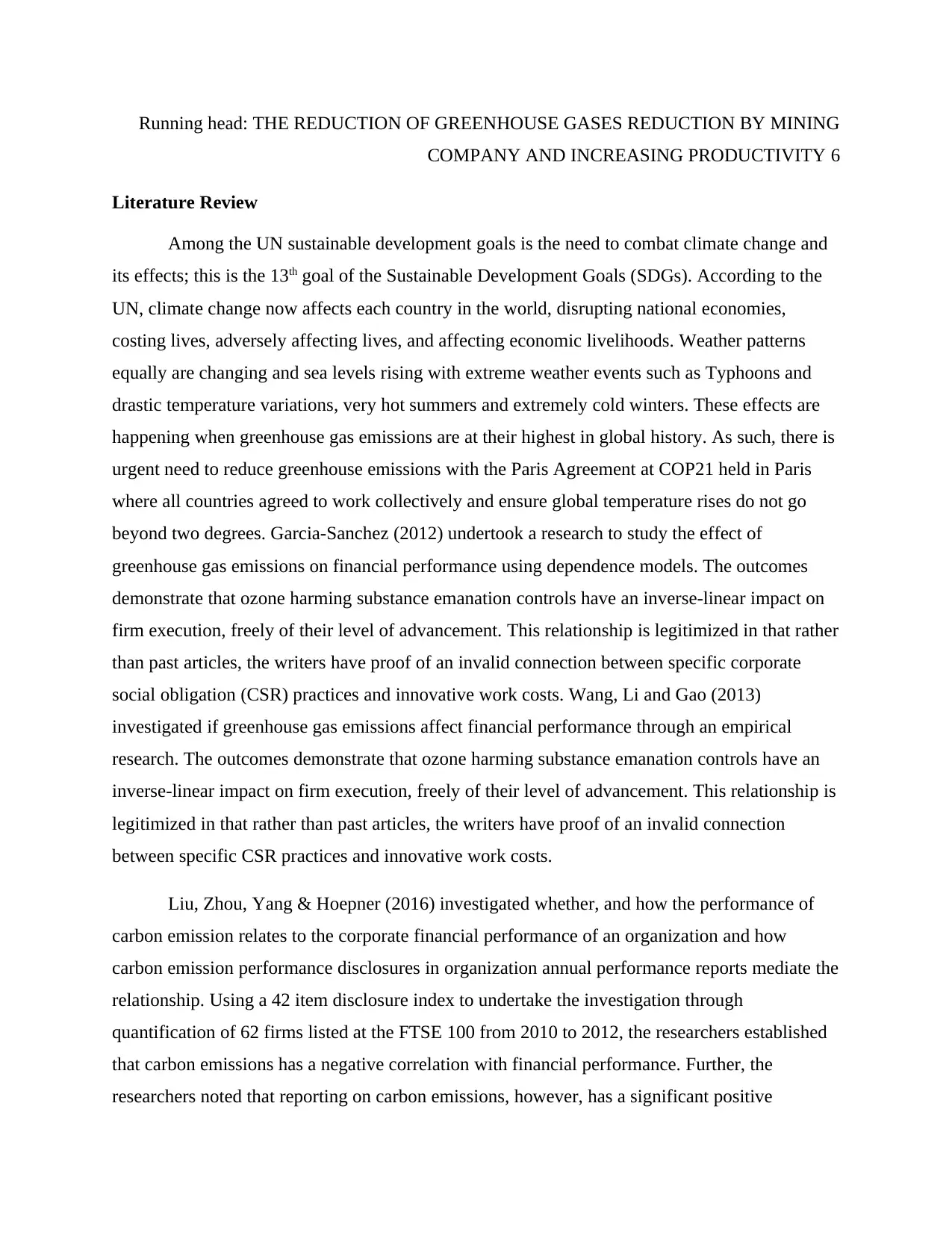
Running head: THE REDUCTION OF GREENHOUSE GASES REDUCTION BY MINING
COMPANY AND INCREASING PRODUCTIVITY 6
Literature Review
Among the UN sustainable development goals is the need to combat climate change and
its effects; this is the 13th goal of the Sustainable Development Goals (SDGs). According to the
UN, climate change now affects each country in the world, disrupting national economies,
costing lives, adversely affecting lives, and affecting economic livelihoods. Weather patterns
equally are changing and sea levels rising with extreme weather events such as Typhoons and
drastic temperature variations, very hot summers and extremely cold winters. These effects are
happening when greenhouse gas emissions are at their highest in global history. As such, there is
urgent need to reduce greenhouse emissions with the Paris Agreement at COP21 held in Paris
where all countries agreed to work collectively and ensure global temperature rises do not go
beyond two degrees. Garcia-Sanchez (2012) undertook a research to study the effect of
greenhouse gas emissions on financial performance using dependence models. The outcomes
demonstrate that ozone harming substance emanation controls have an inverse‐linear impact on
firm execution, freely of their level of advancement. This relationship is legitimized in that rather
than past articles, the writers have proof of an invalid connection between specific corporate
social obligation (CSR) practices and innovative work costs. Wang, Li and Gao (2013)
investigated if greenhouse gas emissions affect financial performance through an empirical
research. The outcomes demonstrate that ozone harming substance emanation controls have an
inverse‐linear impact on firm execution, freely of their level of advancement. This relationship is
legitimized in that rather than past articles, the writers have proof of an invalid connection
between specific CSR practices and innovative work costs.
Liu, Zhou, Yang & Hoepner (2016) investigated whether, and how the performance of
carbon emission relates to the corporate financial performance of an organization and how
carbon emission performance disclosures in organization annual performance reports mediate the
relationship. Using a 42 item disclosure index to undertake the investigation through
quantification of 62 firms listed at the FTSE 100 from 2010 to 2012, the researchers established
that carbon emissions has a negative correlation with financial performance. Further, the
researchers noted that reporting on carbon emissions, however, has a significant positive
COMPANY AND INCREASING PRODUCTIVITY 6
Literature Review
Among the UN sustainable development goals is the need to combat climate change and
its effects; this is the 13th goal of the Sustainable Development Goals (SDGs). According to the
UN, climate change now affects each country in the world, disrupting national economies,
costing lives, adversely affecting lives, and affecting economic livelihoods. Weather patterns
equally are changing and sea levels rising with extreme weather events such as Typhoons and
drastic temperature variations, very hot summers and extremely cold winters. These effects are
happening when greenhouse gas emissions are at their highest in global history. As such, there is
urgent need to reduce greenhouse emissions with the Paris Agreement at COP21 held in Paris
where all countries agreed to work collectively and ensure global temperature rises do not go
beyond two degrees. Garcia-Sanchez (2012) undertook a research to study the effect of
greenhouse gas emissions on financial performance using dependence models. The outcomes
demonstrate that ozone harming substance emanation controls have an inverse‐linear impact on
firm execution, freely of their level of advancement. This relationship is legitimized in that rather
than past articles, the writers have proof of an invalid connection between specific corporate
social obligation (CSR) practices and innovative work costs. Wang, Li and Gao (2013)
investigated if greenhouse gas emissions affect financial performance through an empirical
research. The outcomes demonstrate that ozone harming substance emanation controls have an
inverse‐linear impact on firm execution, freely of their level of advancement. This relationship is
legitimized in that rather than past articles, the writers have proof of an invalid connection
between specific CSR practices and innovative work costs.
Liu, Zhou, Yang & Hoepner (2016) investigated whether, and how the performance of
carbon emission relates to the corporate financial performance of an organization and how
carbon emission performance disclosures in organization annual performance reports mediate the
relationship. Using a 42 item disclosure index to undertake the investigation through
quantification of 62 firms listed at the FTSE 100 from 2010 to 2012, the researchers established
that carbon emissions has a negative correlation with financial performance. Further, the
researchers noted that reporting on carbon emissions, however, has a significant positive
⊘ This is a preview!⊘
Do you want full access?
Subscribe today to unlock all pages.

Trusted by 1+ million students worldwide
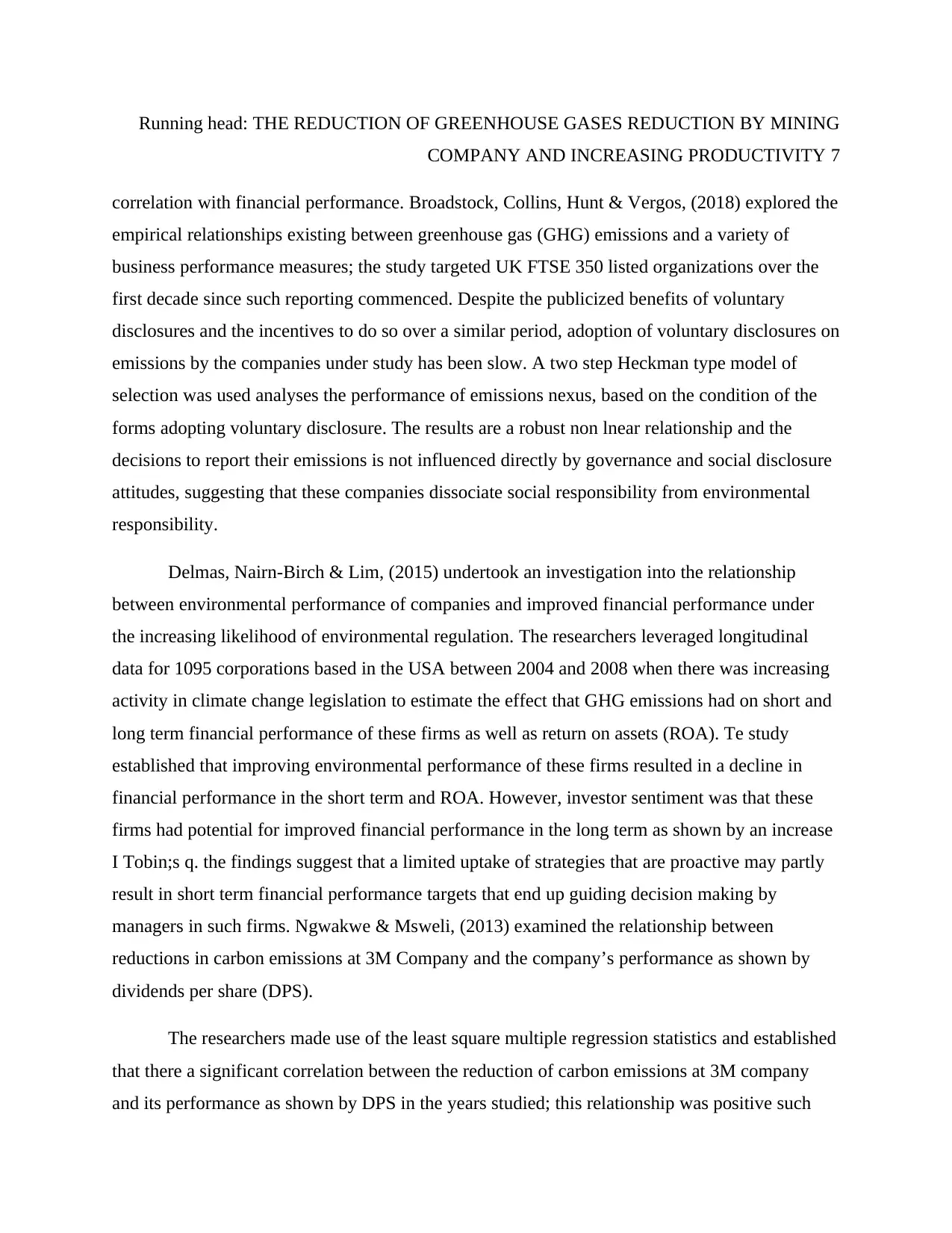
Running head: THE REDUCTION OF GREENHOUSE GASES REDUCTION BY MINING
COMPANY AND INCREASING PRODUCTIVITY 7
correlation with financial performance. Broadstock, Collins, Hunt & Vergos, (2018) explored the
empirical relationships existing between greenhouse gas (GHG) emissions and a variety of
business performance measures; the study targeted UK FTSE 350 listed organizations over the
first decade since such reporting commenced. Despite the publicized benefits of voluntary
disclosures and the incentives to do so over a similar period, adoption of voluntary disclosures on
emissions by the companies under study has been slow. A two step Heckman type model of
selection was used analyses the performance of emissions nexus, based on the condition of the
forms adopting voluntary disclosure. The results are a robust non lnear relationship and the
decisions to report their emissions is not influenced directly by governance and social disclosure
attitudes, suggesting that these companies dissociate social responsibility from environmental
responsibility.
Delmas, Nairn-Birch & Lim, (2015) undertook an investigation into the relationship
between environmental performance of companies and improved financial performance under
the increasing likelihood of environmental regulation. The researchers leveraged longitudinal
data for 1095 corporations based in the USA between 2004 and 2008 when there was increasing
activity in climate change legislation to estimate the effect that GHG emissions had on short and
long term financial performance of these firms as well as return on assets (ROA). Te study
established that improving environmental performance of these firms resulted in a decline in
financial performance in the short term and ROA. However, investor sentiment was that these
firms had potential for improved financial performance in the long term as shown by an increase
I Tobin;s q. the findings suggest that a limited uptake of strategies that are proactive may partly
result in short term financial performance targets that end up guiding decision making by
managers in such firms. Ngwakwe & Msweli, (2013) examined the relationship between
reductions in carbon emissions at 3M Company and the company’s performance as shown by
dividends per share (DPS).
The researchers made use of the least square multiple regression statistics and established
that there a significant correlation between the reduction of carbon emissions at 3M company
and its performance as shown by DPS in the years studied; this relationship was positive such
COMPANY AND INCREASING PRODUCTIVITY 7
correlation with financial performance. Broadstock, Collins, Hunt & Vergos, (2018) explored the
empirical relationships existing between greenhouse gas (GHG) emissions and a variety of
business performance measures; the study targeted UK FTSE 350 listed organizations over the
first decade since such reporting commenced. Despite the publicized benefits of voluntary
disclosures and the incentives to do so over a similar period, adoption of voluntary disclosures on
emissions by the companies under study has been slow. A two step Heckman type model of
selection was used analyses the performance of emissions nexus, based on the condition of the
forms adopting voluntary disclosure. The results are a robust non lnear relationship and the
decisions to report their emissions is not influenced directly by governance and social disclosure
attitudes, suggesting that these companies dissociate social responsibility from environmental
responsibility.
Delmas, Nairn-Birch & Lim, (2015) undertook an investigation into the relationship
between environmental performance of companies and improved financial performance under
the increasing likelihood of environmental regulation. The researchers leveraged longitudinal
data for 1095 corporations based in the USA between 2004 and 2008 when there was increasing
activity in climate change legislation to estimate the effect that GHG emissions had on short and
long term financial performance of these firms as well as return on assets (ROA). Te study
established that improving environmental performance of these firms resulted in a decline in
financial performance in the short term and ROA. However, investor sentiment was that these
firms had potential for improved financial performance in the long term as shown by an increase
I Tobin;s q. the findings suggest that a limited uptake of strategies that are proactive may partly
result in short term financial performance targets that end up guiding decision making by
managers in such firms. Ngwakwe & Msweli, (2013) examined the relationship between
reductions in carbon emissions at 3M Company and the company’s performance as shown by
dividends per share (DPS).
The researchers made use of the least square multiple regression statistics and established
that there a significant correlation between the reduction of carbon emissions at 3M company
and its performance as shown by DPS in the years studied; this relationship was positive such
Paraphrase This Document
Need a fresh take? Get an instant paraphrase of this document with our AI Paraphraser
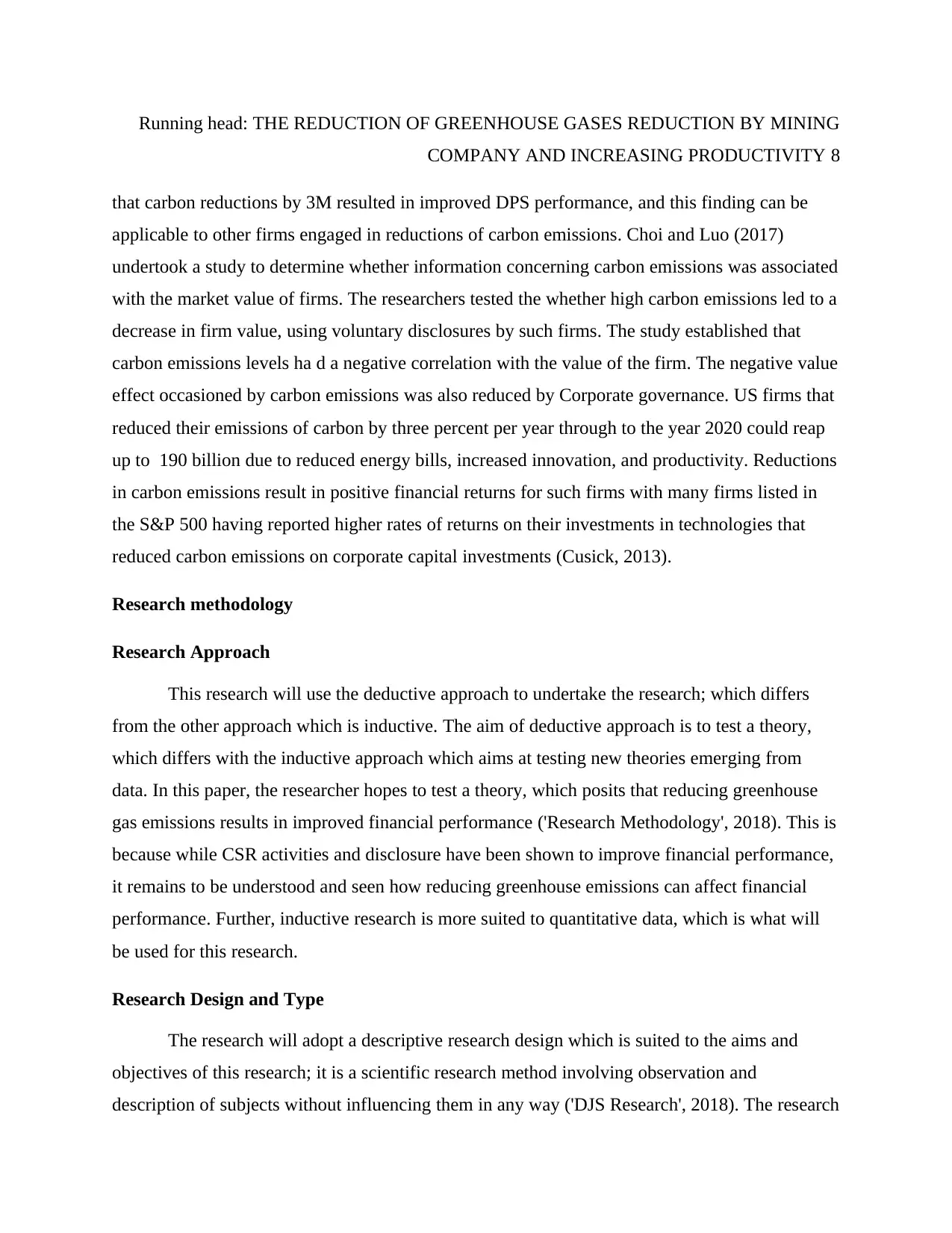
Running head: THE REDUCTION OF GREENHOUSE GASES REDUCTION BY MINING
COMPANY AND INCREASING PRODUCTIVITY 8
that carbon reductions by 3M resulted in improved DPS performance, and this finding can be
applicable to other firms engaged in reductions of carbon emissions. Choi and Luo (2017)
undertook a study to determine whether information concerning carbon emissions was associated
with the market value of firms. The researchers tested the whether high carbon emissions led to a
decrease in firm value, using voluntary disclosures by such firms. The study established that
carbon emissions levels ha d a negative correlation with the value of the firm. The negative value
effect occasioned by carbon emissions was also reduced by Corporate governance. US firms that
reduced their emissions of carbon by three percent per year through to the year 2020 could reap
up to 190 billion due to reduced energy bills, increased innovation, and productivity. Reductions
in carbon emissions result in positive financial returns for such firms with many firms listed in
the S&P 500 having reported higher rates of returns on their investments in technologies that
reduced carbon emissions on corporate capital investments (Cusick, 2013).
Research methodology
Research Approach
This research will use the deductive approach to undertake the research; which differs
from the other approach which is inductive. The aim of deductive approach is to test a theory,
which differs with the inductive approach which aims at testing new theories emerging from
data. In this paper, the researcher hopes to test a theory, which posits that reducing greenhouse
gas emissions results in improved financial performance ('Research Methodology', 2018). This is
because while CSR activities and disclosure have been shown to improve financial performance,
it remains to be understood and seen how reducing greenhouse emissions can affect financial
performance. Further, inductive research is more suited to quantitative data, which is what will
be used for this research.
Research Design and Type
The research will adopt a descriptive research design which is suited to the aims and
objectives of this research; it is a scientific research method involving observation and
description of subjects without influencing them in any way ('DJS Research', 2018). The research
COMPANY AND INCREASING PRODUCTIVITY 8
that carbon reductions by 3M resulted in improved DPS performance, and this finding can be
applicable to other firms engaged in reductions of carbon emissions. Choi and Luo (2017)
undertook a study to determine whether information concerning carbon emissions was associated
with the market value of firms. The researchers tested the whether high carbon emissions led to a
decrease in firm value, using voluntary disclosures by such firms. The study established that
carbon emissions levels ha d a negative correlation with the value of the firm. The negative value
effect occasioned by carbon emissions was also reduced by Corporate governance. US firms that
reduced their emissions of carbon by three percent per year through to the year 2020 could reap
up to 190 billion due to reduced energy bills, increased innovation, and productivity. Reductions
in carbon emissions result in positive financial returns for such firms with many firms listed in
the S&P 500 having reported higher rates of returns on their investments in technologies that
reduced carbon emissions on corporate capital investments (Cusick, 2013).
Research methodology
Research Approach
This research will use the deductive approach to undertake the research; which differs
from the other approach which is inductive. The aim of deductive approach is to test a theory,
which differs with the inductive approach which aims at testing new theories emerging from
data. In this paper, the researcher hopes to test a theory, which posits that reducing greenhouse
gas emissions results in improved financial performance ('Research Methodology', 2018). This is
because while CSR activities and disclosure have been shown to improve financial performance,
it remains to be understood and seen how reducing greenhouse emissions can affect financial
performance. Further, inductive research is more suited to quantitative data, which is what will
be used for this research.
Research Design and Type
The research will adopt a descriptive research design which is suited to the aims and
objectives of this research; it is a scientific research method involving observation and
description of subjects without influencing them in any way ('DJS Research', 2018). The research
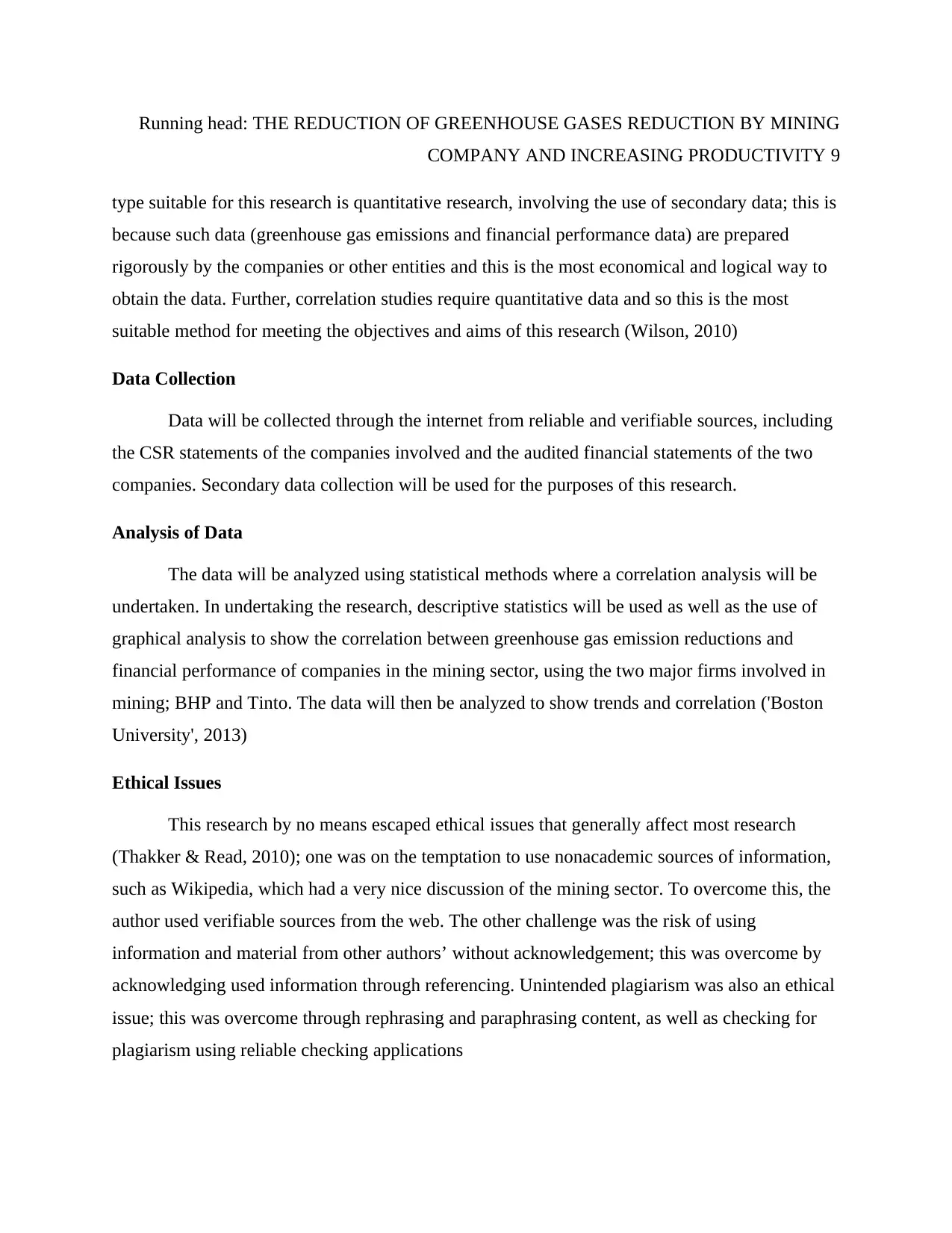
Running head: THE REDUCTION OF GREENHOUSE GASES REDUCTION BY MINING
COMPANY AND INCREASING PRODUCTIVITY 9
type suitable for this research is quantitative research, involving the use of secondary data; this is
because such data (greenhouse gas emissions and financial performance data) are prepared
rigorously by the companies or other entities and this is the most economical and logical way to
obtain the data. Further, correlation studies require quantitative data and so this is the most
suitable method for meeting the objectives and aims of this research (Wilson, 2010)
Data Collection
Data will be collected through the internet from reliable and verifiable sources, including
the CSR statements of the companies involved and the audited financial statements of the two
companies. Secondary data collection will be used for the purposes of this research.
Analysis of Data
The data will be analyzed using statistical methods where a correlation analysis will be
undertaken. In undertaking the research, descriptive statistics will be used as well as the use of
graphical analysis to show the correlation between greenhouse gas emission reductions and
financial performance of companies in the mining sector, using the two major firms involved in
mining; BHP and Tinto. The data will then be analyzed to show trends and correlation ('Boston
University', 2013)
Ethical Issues
This research by no means escaped ethical issues that generally affect most research
(Thakker & Read, 2010); one was on the temptation to use nonacademic sources of information,
such as Wikipedia, which had a very nice discussion of the mining sector. To overcome this, the
author used verifiable sources from the web. The other challenge was the risk of using
information and material from other authors’ without acknowledgement; this was overcome by
acknowledging used information through referencing. Unintended plagiarism was also an ethical
issue; this was overcome through rephrasing and paraphrasing content, as well as checking for
plagiarism using reliable checking applications
COMPANY AND INCREASING PRODUCTIVITY 9
type suitable for this research is quantitative research, involving the use of secondary data; this is
because such data (greenhouse gas emissions and financial performance data) are prepared
rigorously by the companies or other entities and this is the most economical and logical way to
obtain the data. Further, correlation studies require quantitative data and so this is the most
suitable method for meeting the objectives and aims of this research (Wilson, 2010)
Data Collection
Data will be collected through the internet from reliable and verifiable sources, including
the CSR statements of the companies involved and the audited financial statements of the two
companies. Secondary data collection will be used for the purposes of this research.
Analysis of Data
The data will be analyzed using statistical methods where a correlation analysis will be
undertaken. In undertaking the research, descriptive statistics will be used as well as the use of
graphical analysis to show the correlation between greenhouse gas emission reductions and
financial performance of companies in the mining sector, using the two major firms involved in
mining; BHP and Tinto. The data will then be analyzed to show trends and correlation ('Boston
University', 2013)
Ethical Issues
This research by no means escaped ethical issues that generally affect most research
(Thakker & Read, 2010); one was on the temptation to use nonacademic sources of information,
such as Wikipedia, which had a very nice discussion of the mining sector. To overcome this, the
author used verifiable sources from the web. The other challenge was the risk of using
information and material from other authors’ without acknowledgement; this was overcome by
acknowledging used information through referencing. Unintended plagiarism was also an ethical
issue; this was overcome through rephrasing and paraphrasing content, as well as checking for
plagiarism using reliable checking applications
⊘ This is a preview!⊘
Do you want full access?
Subscribe today to unlock all pages.

Trusted by 1+ million students worldwide
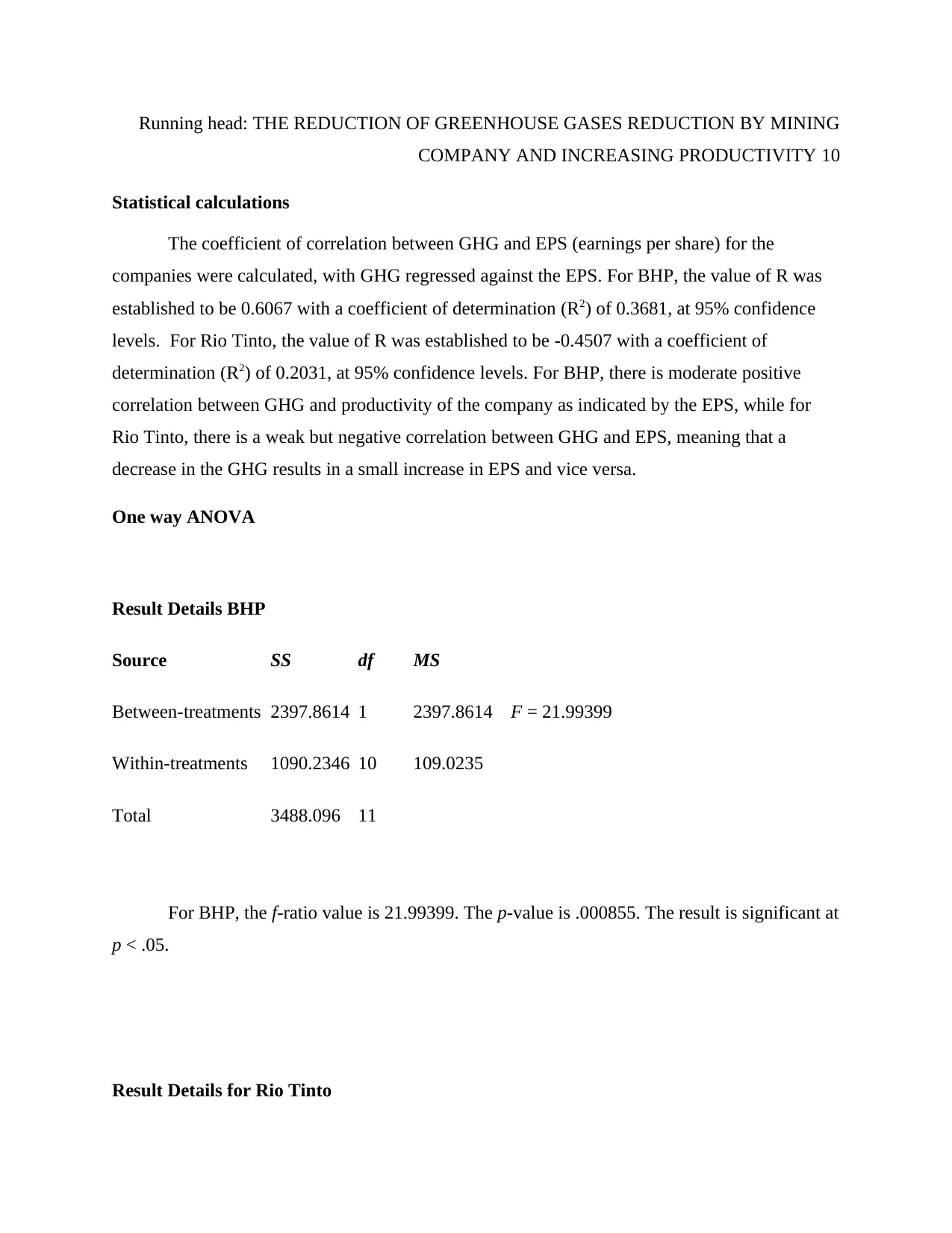
Running head: THE REDUCTION OF GREENHOUSE GASES REDUCTION BY MINING
COMPANY AND INCREASING PRODUCTIVITY 10
Statistical calculations
The coefficient of correlation between GHG and EPS (earnings per share) for the
companies were calculated, with GHG regressed against the EPS. For BHP, the value of R was
established to be 0.6067 with a coefficient of determination (R2) of 0.3681, at 95% confidence
levels. For Rio Tinto, the value of R was established to be -0.4507 with a coefficient of
determination (R2) of 0.2031, at 95% confidence levels. For BHP, there is moderate positive
correlation between GHG and productivity of the company as indicated by the EPS, while for
Rio Tinto, there is a weak but negative correlation between GHG and EPS, meaning that a
decrease in the GHG results in a small increase in EPS and vice versa.
One way ANOVA
Result Details BHP
Source SS df MS
Between-treatments 2397.8614 1 2397.8614 F = 21.99399
Within-treatments 1090.2346 10 109.0235
Total 3488.096 11
For BHP, the f-ratio value is 21.99399. The p-value is .000855. The result is significant at
p < .05.
Result Details for Rio Tinto
COMPANY AND INCREASING PRODUCTIVITY 10
Statistical calculations
The coefficient of correlation between GHG and EPS (earnings per share) for the
companies were calculated, with GHG regressed against the EPS. For BHP, the value of R was
established to be 0.6067 with a coefficient of determination (R2) of 0.3681, at 95% confidence
levels. For Rio Tinto, the value of R was established to be -0.4507 with a coefficient of
determination (R2) of 0.2031, at 95% confidence levels. For BHP, there is moderate positive
correlation between GHG and productivity of the company as indicated by the EPS, while for
Rio Tinto, there is a weak but negative correlation between GHG and EPS, meaning that a
decrease in the GHG results in a small increase in EPS and vice versa.
One way ANOVA
Result Details BHP
Source SS df MS
Between-treatments 2397.8614 1 2397.8614 F = 21.99399
Within-treatments 1090.2346 10 109.0235
Total 3488.096 11
For BHP, the f-ratio value is 21.99399. The p-value is .000855. The result is significant at
p < .05.
Result Details for Rio Tinto
Paraphrase This Document
Need a fresh take? Get an instant paraphrase of this document with our AI Paraphraser
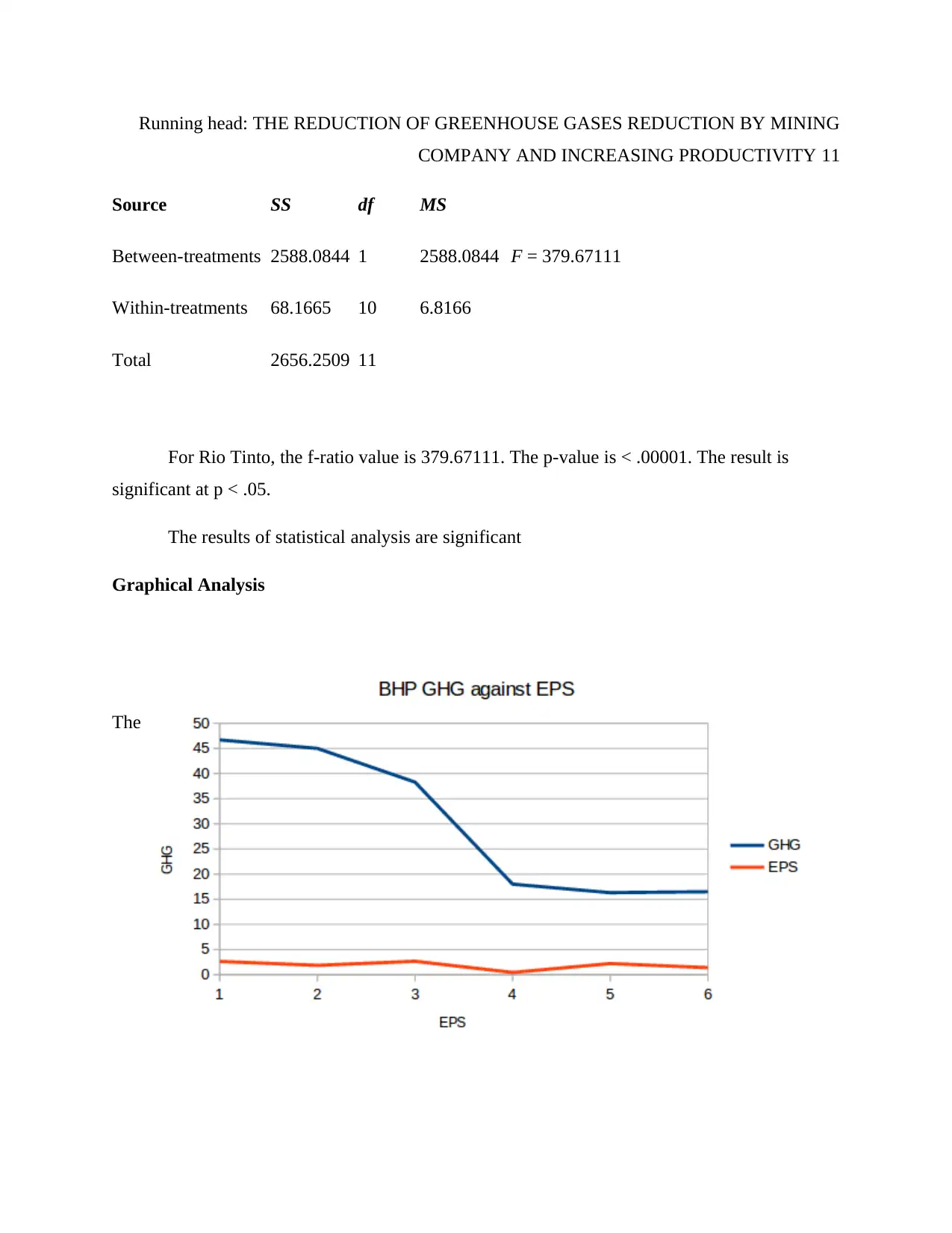
Running head: THE REDUCTION OF GREENHOUSE GASES REDUCTION BY MINING
COMPANY AND INCREASING PRODUCTIVITY 11
Source SS df MS
Between-treatments 2588.0844 1 2588.0844 F = 379.67111
Within-treatments 68.1665 10 6.8166
Total 2656.2509 11
For Rio Tinto, the f-ratio value is 379.67111. The p-value is < .00001. The result is
significant at p < .05.
The results of statistical analysis are significant
Graphical Analysis
The
COMPANY AND INCREASING PRODUCTIVITY 11
Source SS df MS
Between-treatments 2588.0844 1 2588.0844 F = 379.67111
Within-treatments 68.1665 10 6.8166
Total 2656.2509 11
For Rio Tinto, the f-ratio value is 379.67111. The p-value is < .00001. The result is
significant at p < .05.
The results of statistical analysis are significant
Graphical Analysis
The
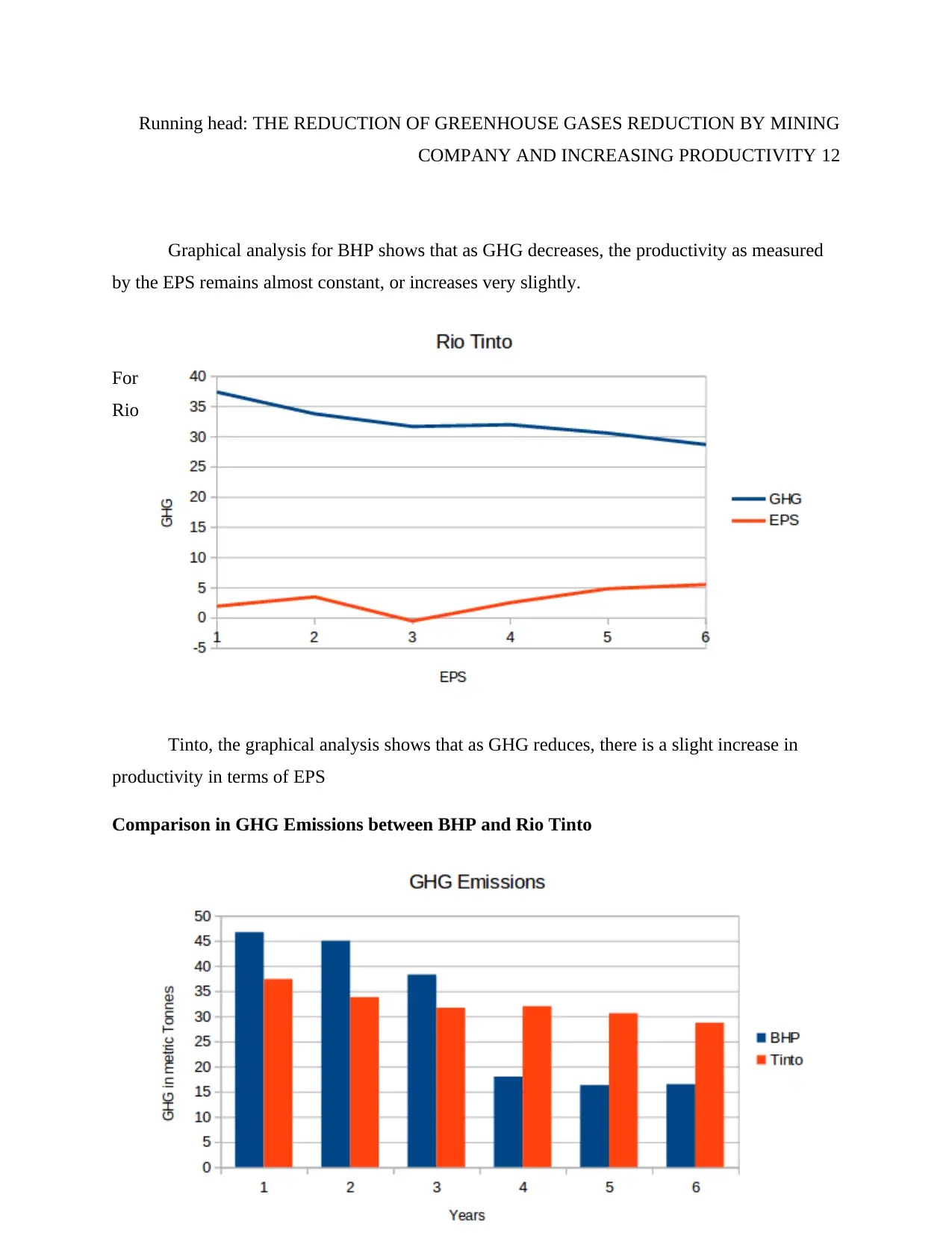
Running head: THE REDUCTION OF GREENHOUSE GASES REDUCTION BY MINING
COMPANY AND INCREASING PRODUCTIVITY 12
Graphical analysis for BHP shows that as GHG decreases, the productivity as measured
by the EPS remains almost constant, or increases very slightly.
For
Rio
Tinto, the graphical analysis shows that as GHG reduces, there is a slight increase in
productivity in terms of EPS
Comparison in GHG Emissions between BHP and Rio Tinto
COMPANY AND INCREASING PRODUCTIVITY 12
Graphical analysis for BHP shows that as GHG decreases, the productivity as measured
by the EPS remains almost constant, or increases very slightly.
For
Rio
Tinto, the graphical analysis shows that as GHG reduces, there is a slight increase in
productivity in terms of EPS
Comparison in GHG Emissions between BHP and Rio Tinto
⊘ This is a preview!⊘
Do you want full access?
Subscribe today to unlock all pages.

Trusted by 1+ million students worldwide
1 out of 19
Related Documents
Your All-in-One AI-Powered Toolkit for Academic Success.
+13062052269
info@desklib.com
Available 24*7 on WhatsApp / Email
![[object Object]](/_next/static/media/star-bottom.7253800d.svg)
Unlock your academic potential
Copyright © 2020–2025 A2Z Services. All Rights Reserved. Developed and managed by ZUCOL.





